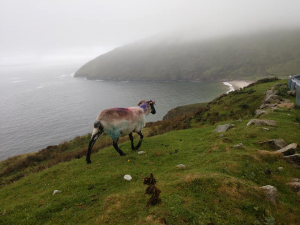When you think of Ireland, what do you think of? Rolling green hills? Beautiful sheep on pasture? Green grass and cliffs?
If that’s what you perceive, I’d say you’re correct! I recently visited Ireland and learned all about Irish agriculture, and I’d say it did not disappoint. After meeting with Bord Bia — The Irish Food Foard and several farmers, speaking at the International Association of Plant Biotechnology Conference, chatting with scientists and experts from Teagasc (the Irish food and farm authority responsible for R&D, training, advisory, and other things) and meeting with other Irish based agriculture companies like Alltech, I learned so much about all different facets of Irish farming.

There were some similarities between Irish and American agriculture but also many differences. In Ireland about 10 percent of their nearly 5 million people are involved in agriculture, and the average farm size is 80 acres. This is a far cry from the 400-acre average farm in the U.S. and 1 percent of our 360 million people. While we as Americans tend to finish livestock on grain (very efficient!), Ireland does most of their livestock grass finished.
Why? Because they can. The rainfall, soil, and climate make for good conditions. Not as much of the land is tillable, and grass is cheap/free. It just makes the most sense, whereas I think of my own farm, for example: We get extreme weather like snow and ice, extreme heat and other weather issues, etc. Ireland produces enough food for 50 million people and has 180 export markets, the U.K. being No. 1. Meat and dairy is two-thirds of their exports. It’s also important to remember marketing. Ireland very much prides themselves on that “green” image, and rightfully so! People love to see beautiful animals grazing in pasture — who doesn’t love that?
The downfall of grass-based is that it tends to be higher in ghg emissions, but they’re working on cutting that down. Companies such as Alltech make ruminant nutrition products to improve feed efficiencies. These are technologies the USA has really embraced — feed conversion rates, grain fed, growth hormones, producing more food with less animals and resources. On our farm in Iowa, our cattle go to market at around 18 months and 1,400 pounds or so (give or take). Irish cattle could be 26 months which means that much more water, feed, methane, and other resources.
But … marketing. It’s no secret some people say “yuck” to the idea of feedlots and added hormones. Scientifically speaking, these methods are proven. In the U.S., agriculture accounts for only 9 percent of ghg emissions, 2 percent of that coming from livestock. Irish agriculture accounts for nearly 50 percent of ghg emissions! They’re working on reducing that though. Instead of saying, “We need more milk so let’s get more cows,” the answer, from an environmental perspective could be: “How do we use science to our advantage to make our current cow population produce more milk with fewer resources?” This is where the U.S. excels.
But, hey, no system is perfect, it’s never black and white. Everything has its advantages and disadvantages, but I do personally enjoy learning more about how we can all work together, learn from one another, and improve our planet overall.
So, here was one of the COOLEST things I learned! They know more about livestock than people! Each animal is born with a “passport,” and they can track any product back to the farm it was raised on. Farmers track all data, genetics, improvements, etc., and it’s all put into a database. The average beef farm size is 17 cows, whereas for dairy the average farm size is 80 cows. There’s 130,000 farm holdings in Ireland, and every farm is held to high traceability standards. Farms are also audited every 18 months, where the “Origin Green” group from Bord Bia visits the farms to analyze their carbon footprint and check records for fertilizer use, antibiotics, and other inputs. Farms are also given financial incentives for helping pollinators, improving wildlife habitats, etc. They’re then given a farm performance report with up to 190 different criteria.
In Irish agriculture, they’re always working with farmers for new quality assurance and sustainability programs. So, the next time you’re in Ireland, ask the farmers all about it! In addition to experiencing those beautiful green hills and cliffs that we all know and love, it’s important to learn about their engaging and interesting programs. For more info, visit www.origingreen.ie
Michelle Miller, the Farm Babe, is an Iowa-based farmer, public speaker, and writer, who lives and works with her boyfriend on their farm, which consists of row crops, beef cattle, and sheep. She believes education is key in bridging the gap between farmers and consumers.



